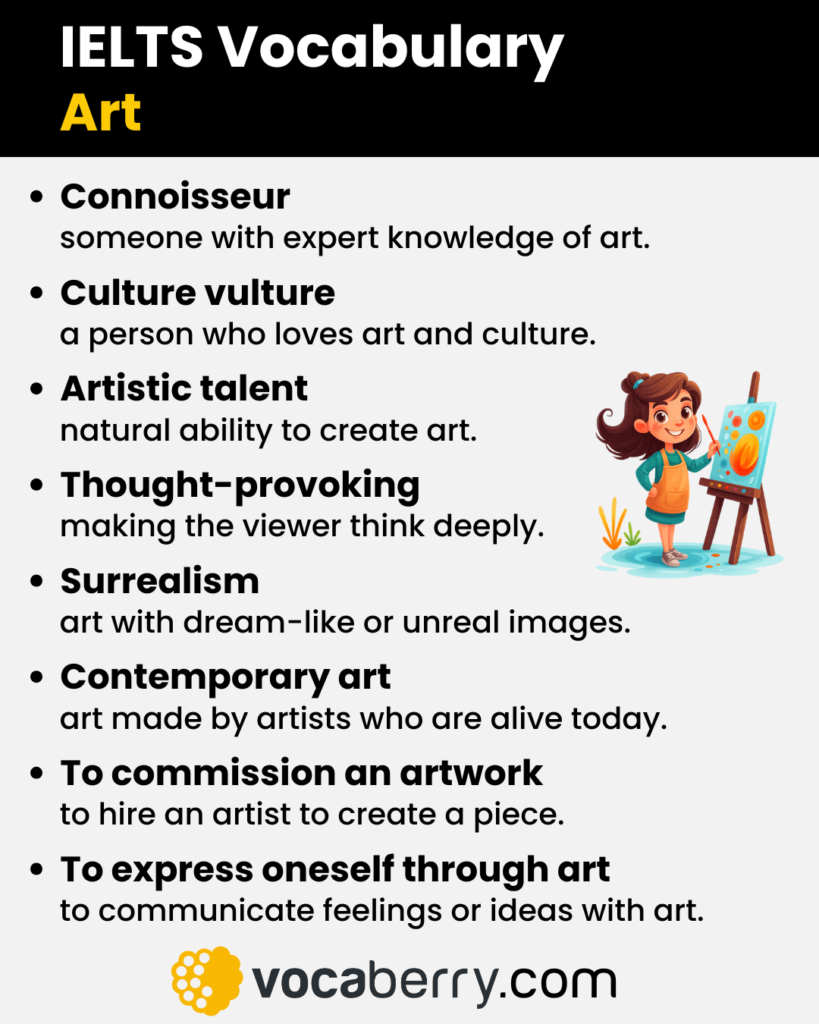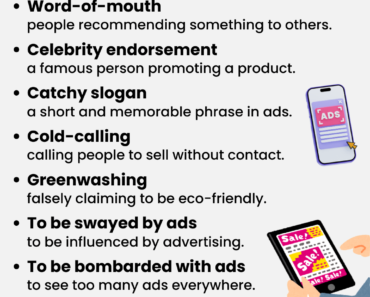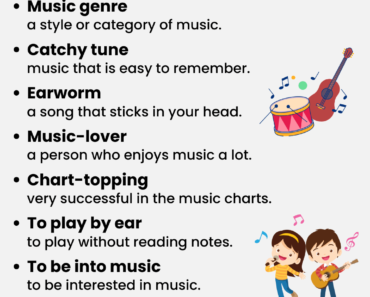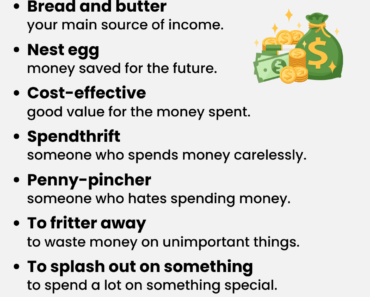
Art is a common topic in the IELTS Speaking test. Examiners may ask you about your favorite artists, types of art you enjoy, visits to galleries or museums, and opinions on the role of art in society. In this guide, you’ll learn useful IELTS vocabulary for art with clear definitions, followed by IELTS Speaking Part 1, Part 2, and Part 3 questions with sample answers.
IELTS Vocabulary for Art
Here is some useful IELTS vocabulary for talking about art with clear definitions. These words and phrases will help you give better answers in the IELTS Speaking test.
- Culture vulture – a person who loves art and culture.
- Artwork – a creative piece like a painting or sculpture.
- Artist – someone who creates art.
- Sculptor – an artist who makes sculptures.
- Gallery – a place where art is displayed.
- Exhibition – an event showing artworks to the public.
- Masterpiece – an artist’s best or most famous work.
- Work of art – a beautiful or valuable artistic creation.
- Abstract art – art that does not represent real objects.
- Figurative art – art that shows real objects or people.
- Contemporary art – art made by artists who are alive today.
- Modern art – experimental art from the 20th century.
- Classical art – traditional or historical styles of art.
- Still life – a painting of objects, usually everyday items.
- Landscape – a painting or photograph of natural scenery.
- Portrait – a painting or drawing of a person.
- Art installation – a large artwork created for a specific space.
- Street art – artwork created in public spaces, often graffiti.
- Fine arts – traditional visual art like painting or sculpture.
- Visual arts – art you can see, like painting or photography.
- Performing arts – art forms like dance, drama, and music.
- Digital art – art created using computers or digital tools.
- Art movement – a style or trend in art during a certain period.
- Brushstroke – a single movement of a brush in painting.
- Palette – the range of colors used by an artist.
- Artistic style – a distinctive way an artist creates their work.
- Mixed media – art made with different materials.
- Minimalist art – simple art with few elements.
- Symbolism – using symbols to show meaning.
- Expressionism – an art style that shows intense emotions.
- Surrealism – art with dream-like or unreal images.
- Visual storytelling – telling a story through images.
- Thought-provoking – making the viewer think deeply.
- Conceptual art – art focused on ideas over looks.
- Aesthetic value – the beauty or artistic quality of something.
- Creative expression – showing feelings or ideas through art.
- Art appreciation – understanding and enjoying art.
- To interpret art – to explain an artwork’s meaning.
- To portray – to represent someone or something in art.
- To capture emotion – to show or express feelings in a piece of art.
- Inspiration – a feeling that motivates an artist to create.
- Creativity – the ability to produce original and imaginative ideas.
- Artistic talent – natural ability to create art.
- To be inspired by – to get creative motivation from something.
- To be moved by – to feel strong emotion from art.
- Cultural heritage – traditions and art passed down.
- Art lover – someone who enjoys and values art.
- Art critic – a person who reviews and evaluates artworks.
- Curator – someone who organizes exhibitions.
- Mural – a large painting on a wall.
- To curate an exhibition – to select and arrange art.
- To commission an artwork – to hire an artist to create a piece.
- To be a connoisseur of – to know and appreciate a specific art form.
- To express oneself through art – to communicate feelings or ideas with art.
IELTS Speaking: Art Questions & Answers
In this section, you’ll find IELTS Speaking Part 1, Part 2, and Part 3 questions on art with sample answers. These examples show how the art-related vocabulary can be used in your responses during the test.
IELTS Speaking Part 1 – Art
Do you like art?
Yes, I do. I’ve always enjoyed visiting galleries and looking at different forms of visual arts. I may not be an artist myself, but I appreciate how people use creative expression to share their thoughts and emotions.
Did you learn about art at school?
Yes, we had basic art appreciation lessons in school. We learned about different art movements, famous masterpieces, and even tried some still life drawing. It helped me understand how art reflects culture and emotion.
Do you draw or paint in your free time?
Not really, but sometimes I sketch for fun. I wouldn’t say I have much artistic talent, but I do enjoy using simple brushstrokes and playing with a palette of colors just to express myself through art when I feel inspired.
What kind of art do you enjoy most?
I’m especially drawn to abstract art and modern art. I like how these styles focus more on ideas and feelings rather than realistic images. Some pieces are really thought-provoking and let the viewer interpret the meaning in their own way.
Do you prefer traditional or digital art?
I think both are interesting in their own way. Classical art has a timeless beauty, especially the masterpieces you see in museums. But I also find digital art fascinating because it blends creativity with modern technology.
IELTS Speaking Part 2 – Art Cue Card
Describe a piece of art that you like.
You should say:
- what it is
- when and where you saw it
- what it looks like
- and explain why you like it
Sample Answer:
One piece of art that really left a lasting impression on me is a large mural I saw while visiting Melbourne, Australia. It was part of a local street art festival where different artists were invited to transform city walls into open-air galleries. I came across this particular work of art while walking through a laneway that was completely covered in colorful pieces, but this one stood out immediately.
The mural was huge, covering the entire side of a building. It showed a woman holding a child, surrounded by birds, broken clocks, and floating leaves. The colors were rich and warm, and the details were incredible. The artist used bold brushstrokes and layered textures that gave the piece so much depth. The entire image was full of symbolism, and it was clear the message was about time, memory, and human connection. The style reminded me a little of expressionism, where the focus is on conveying raw emotion rather than perfect form.
What I appreciated most was how powerful the creative expression was. You could really feel the emotions the artist was trying to capture. Even without reading any description, I felt moved by it almost instantly. It made me pause and reflect, which I think is the goal of any meaningful artwork.
I also found it inspiring because it wasn’t displayed in a gallery or exhibition. It was out in the open, part of everyday life, and that made it even more impactful. To me, it was a true masterpiece. It combined visual beauty with emotional depth and showed how art can connect with people in a powerful and public way.
IELTS Speaking Part 3 – Art Discussion
IELTS Speaking Part 3 questions about art often ask you to compare different styles, discuss the value of art in education and society, and give opinions on how art influences culture and everyday life.
Why do people enjoy looking at art?
People enjoy looking at art because it allows them to connect emotionally or mentally without needing words. A powerful work of art can remind someone of personal memories, or simply make them feel something unexpected. The visual appeal, especially the artistic style and use of color or symbolism, can be very thought-provoking. Some are drawn to technical skill, while others appreciate how artists express themselves through art. I think it’s this emotional connection and space for personal interpretation that makes art enjoyable for so many people.
Do you think art is important for society?
Yes, I believe art is deeply important for society. It reflects our cultural heritage, values, and struggles. Through things like street art, murals, or public installations, artists can raise awareness or challenge the way we think. Thought-provoking artworks often start conversations around social and political issues. What’s more, art brings people together, whether in a gallery, exhibition, or online. It’s not just decorative; it’s a powerful form of creative expression and communication that helps society grow and reflect on itself.
How can children benefit from learning art?
Learning art offers many benefits for children. It helps them develop creativity, problem-solving, and emotional awareness. Through painting or drawing, they learn how to express themselves through art, which can build confidence and reduce stress. Even working on simple still life drawings teaches focus and patience. Beyond that, exploring different art movements or practicing art appreciation helps them understand other cultures and viewpoints. Overall, art helps children become more thoughtful, imaginative, and open-minded individuals.
How has the role of the artist changed in modern times?
In the past, artists were often limited to traditional subjects and techniques, like religious or royal portraits. Today, they have much more freedom. Many now explore digital art, mixed media, and global issues through their work. Some use art as activism, raising awareness through their installations or online platforms. Thanks to technology, artists can reach wide audiences and experiment with styles like conceptual art. So the modern artist is not just a creator, but also a communicator, influencer, and sometimes even a social critic.
More IELTS Vocabulary Topics
If you found this lesson useful, explore other IELTS Speaking topics to expand your vocabulary and practice with sample answers:
- IELTS Vocabulary: Accommodation
- IELTS Vocabulary: Advertisement
- IELTS Vocabulary: Animals
- IELTS Vocabulary: Artificial Intelligence
- IELTS Vocabulary: Books
- IELTS Vocabulary: Childhood
- IELTS Vocabulary: Crime and Punishment
- IELTS Vocabulary: Culture and Traditions
- IELTS Vocabulary: Daily Routine
- IELTS Vocabulary: Education
- IELTS Vocabulary: Environment
- IELTS Vocabulary: Family
- IELTS Vocabulary: Fashion and Clothes
- IELTS Vocabulary: Films
- IELTS Vocabulary: Food & Diet
- IELTS Vocabulary: Friends
- IELTS Vocabulary: Gifts
- IELTS Vocabulary: Health
- IELTS Vocabulary: Hobbies
- IELTS Vocabulary: Hometown
- IELTS Vocabulary: Money
- IELTS Vocabulary: Museums
- IELTS Vocabulary: Music
- IELTS Vocabulary: Plants
- IELTS Vocabulary: Shopping
- IELTS Vocabulary: Social Media
- IELTS Vocabulary: Sports
- IELTS Vocabulary: Technology
- IELTS Vocabulary: Transport
- IELTS Vocabulary: Travel
- IELTS Vocabulary: Weather
- IELTS Vocabulary: Work & Jobs






